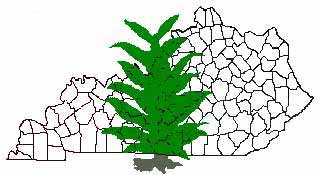

June 26
Crop, Soil, & Pest Management Field School, UK Spindletop Farm, Lexington, KY.
4 General hours: Categories 1 (Ag Applicator), 10 (Demo and Research), 12 (Retail Pesticide Sales Agent).
Contact: Dr. J. D. Green (859) 257-4898.

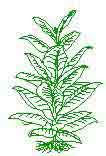 A BLUE MOLD WATCH remains for Southeastern Kentucky with an ADVISORY statewide: To our knowledge, blue mold has not been confirmed in
Kentucky, Indiana, Ohio, Missouri, or West Virginia as of June 8. The closest confirmed activity is from Green County in eastern Tennessee.
The level of blue mold development has increased significantly in southern Georgia during the past couple of weeks resulting in increased
spore loads moving north. However, the potential for blue mold development in the Ohio River Valley continues to increase as the cool, wet
weather persists and the disease builds in the southeastern USA. The highest potential is in southeastern Kentucky due to its proximity to the
activity in east Tennessee and the increased risk throughout the southern Appalachian Mountains. All should appreciate that cloudy weather is
keeping the plants highly susceptible and environmental conditions are highly favorable for infection to occur, if viable spores arrive. Winds
from the sources mentioned above may have carried spores across a wide front into Kentucky, so growers are advised to maintain aggressive
fungicide programs in all transplant production and holding situations, and to scout field plants at least twice weekly for blue mold.
Should blue mold be found within a county weekly fungicide spray programs with Acrobat MZ should be immediately put in place, followed by
activation of the plant with Actigard 50W once the plants are 18 inches tall and able to tolerate the treatment. This preventive program should
already be in place for areas under a watch or warning. Additional sprays of Acrobat MZ may also be needed after the second application of
Actigard if strong blue mold pressure is present, especially for late maturing varieties.
A BLUE MOLD WATCH remains for Southeastern Kentucky with an ADVISORY statewide: To our knowledge, blue mold has not been confirmed in
Kentucky, Indiana, Ohio, Missouri, or West Virginia as of June 8. The closest confirmed activity is from Green County in eastern Tennessee.
The level of blue mold development has increased significantly in southern Georgia during the past couple of weeks resulting in increased
spore loads moving north. However, the potential for blue mold development in the Ohio River Valley continues to increase as the cool, wet
weather persists and the disease builds in the southeastern USA. The highest potential is in southeastern Kentucky due to its proximity to the
activity in east Tennessee and the increased risk throughout the southern Appalachian Mountains. All should appreciate that cloudy weather is
keeping the plants highly susceptible and environmental conditions are highly favorable for infection to occur, if viable spores arrive. Winds
from the sources mentioned above may have carried spores across a wide front into Kentucky, so growers are advised to maintain aggressive
fungicide programs in all transplant production and holding situations, and to scout field plants at least twice weekly for blue mold.
Should blue mold be found within a county weekly fungicide spray programs with Acrobat MZ should be immediately put in place, followed by
activation of the plant with Actigard 50W once the plants are 18 inches tall and able to tolerate the treatment. This preventive program should
already be in place for areas under a watch or warning. Additional sprays of Acrobat MZ may also be needed after the second application of
Actigard if strong blue mold pressure is present, especially for late maturing varieties.
To aid in controlling blue mold in the burley belt-at-large, I strongly discourage the movement of transplants out of southeastern Kentucky/east Tennessee to other regions. Appreciate that once established within the burley region, growers moving transplants need to seriously consider the risk from plants within the region as well as those from without! Additional regions will be added to this higher risk list as additional outbreaks of blue mold are documented.
Should blue mold be found, immediately get sample material to one of our two Plant Disease Diagnostic Labs for confirmation and testing. This is required for the first outbreak in each Kentucky county. We have already had several suspected cases submitted, in which the submitter was confident they were dealing with blue mold. But in each of these cases, diseases or disorders other than blue mold were involved. Let's take steps to insure we are not dealing with rumors of blue mold!
Application guidelines for the fungicides labeled for blue mold control in transplant production systems and in the field in Kentucky have been presented in recent issues of Kentucky Pest News:
Transplant fungicides in the March 24, 2003 issue number 978 at web address- http://www.uky.edu/Agriculture/kpn/kpn_03/pi030324.htm
Field fungicides in the April 28, 2003 issue number 983 at
web address -
http://www.uky.edu/Agriculture/kpn/kpn_03/pi030428.htm
For the latest blue mold status and other tobacco disease information, check the KY Blue Mold Warning System online.
![]() http://www.uky.edu/Agriculture/kpn/kyblue/kyblue.htm
http://www.uky.edu/Agriculture/kpn/kyblue/kyblue.htm
 Black cutworm moths lay their eggs on a wide range of
plants. Weed growth in many fields during rain delays in
setting this year has provided excellent spots for female
moths to leave their eggs and also "starter rations" for
newly hatched cutworms. While final field preparation
destroys the weeds, many of the cutworms present survive
to feed on newly set tobacco transplants. Wet soils have
allowed cutworms to remain near the surface where they
will feed on leaves or chew through stems, cutting off and
killing individual plants.
Black cutworm moths lay their eggs on a wide range of
plants. Weed growth in many fields during rain delays in
setting this year has provided excellent spots for female
moths to leave their eggs and also "starter rations" for
newly hatched cutworms. While final field preparation
destroys the weeds, many of the cutworms present survive
to feed on newly set tobacco transplants. Wet soils have
allowed cutworms to remain near the surface where they
will feed on leaves or chew through stems, cutting off and
killing individual plants.
The degree of cutworm suppression provided by
transplant water treatments varies from good for Orthene
to poor for the systemic aphid control products, which
have no apparent activity on caterpillars in general.
Orthene is labeled for use as a rescue treatment for
cutworms. Results will be most satisfactory when the
cutworms are feeding on leaves or above the soil line.
See "Insect Management Recommendations" for more insecticide recommendations on tobacco and other crops and livestock.
The tobacco insect pest lineup is relatively predictable each season but the intensity of infestations is not. Also, a surprise pest occasionally may show up. That's why weekly field checks can make you money - either by catching problems early and allowing corrective action before economic losses occur, or by saving time and money where treatments are not needed.
It is wise to anticipate flea beetle, hornworm, and budworms in the earliest set fields. To assess their numbers, check leaves for the small round holes caused by flea beetles and look for the small insects on transplant leaves. An average of 3 or more beetles per plant is sufficient to warrant control. After looking at the leaves, carefully examine the bud area of groups of 10 plants in at least 5 different areas of the field. Look for small, round holes in the bud leaves, young budworms, and their pepper-like droppings. An insecticide should be applied if a total of 5 or more budworms are found per 50 plants. An early flight of hornworm moths can result in enough of these destructive caterpillars to devour small transplants. As with budworms, 5 or more per 50 plants justifies a treatment.
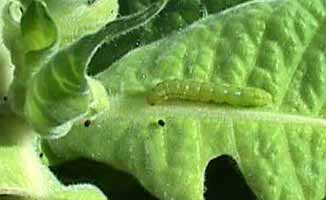 Keys to effective budworm / hornworm control.
Keys to effective budworm / hornworm control.
For more information about tobacco pests, visit "Insect Management Recommendations".
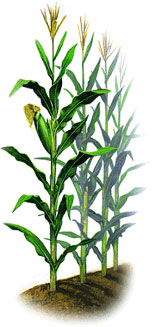
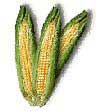 During early June, several corn samples have come into
the University of Kentucky Plant Diagnostic Laboratory
showing symptoms of stunting and root rot. Various parts
of the root system exhibited brownish decay: the seedling
roots, the mesocotyls (the "root" connecting the seed and
seedling roots with the crown), and the first set of nodal
roots.
During early June, several corn samples have come into
the University of Kentucky Plant Diagnostic Laboratory
showing symptoms of stunting and root rot. Various parts
of the root system exhibited brownish decay: the seedling
roots, the mesocotyls (the "root" connecting the seed and
seedling roots with the crown), and the first set of nodal
roots.
In the laboratory, we have observed evidence of infection by Pythium and Fusarium microbes in diseased roots. Pythium species are common causes of root decay in corn seedlings when soil conditions are cool and wet, which describes well the conditions we have experienced throughout most of Kentucky for much of the mid- to late spring. Fusarium species are also reported as significant causes of corn seedling root rots this spring in neighboring states as well as here.
To my knowledge, all commercial corn seed is treated with metalaxyl/mefanoxam. These fungicides which are, for practical purposes, identical active ingredients provide 10- 14 days of protection from infection by Pythium species. However, given the sustained wet weather many fields have experienced this spring, Pythium pressure was greater than the seed treatment can handle. Fludioxanil fungicide, the active ingredient in Maxim , provides protection against Fusarium species. However, while both fungicides are systemic, they translocate upward in the plant towards the leaves not downward towards the roots. Thus, several weeks of sustained wet weather has left the roots vulnerable to infection.
Seedling root rots of corn are normally more damaging in corn that is under stress. In some circumstances, the unusually wet conditions may be enough to set a crop up for damage. In others, there may be additional factors that predispose the crop to damage from these diseases: improper herbicide application, seed of low vigor, etc. Also, since Pythium species are favored by saturated soil conditions, compacted soil horizons can increase disease pressure. If corn seedling root rots are observed, it would pay to evaluate the agronomics of the field to see if improvements could be made.
 The cool, mild weather has held back the development of
corn this spring and extended the period for cutworm
attack. Reports of cutworm activity in isolated parts of the
state continue. While corn remains less than 12 to 18 inches
in height, it is still vulnerable to cutworm attack. Growers
need to continue to monitor their late planted corn for
cutworm activity and pay particular attention to fields with
corn less than 18 inches tall.
The cool, mild weather has held back the development of
corn this spring and extended the period for cutworm
attack. Reports of cutworm activity in isolated parts of the
state continue. While corn remains less than 12 to 18 inches
in height, it is still vulnerable to cutworm attack. Growers
need to continue to monitor their late planted corn for
cutworm activity and pay particular attention to fields with
corn less than 18 inches tall.
For more information about corn pests, visit "Insect Management Recommendations".
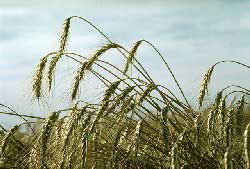
 There have been a number of questions about using as a
preharvest treatment to manage Italian ryegrass in
wheat. Several glyphosate products are registered as a
preharvest to wheat, however, UK research has shown
that the difference in maturity between wheat and
ryegrass is not large enough to gain any benefit for
preventing production of viable ryegrass seed.
There have been a number of questions about using as a
preharvest treatment to manage Italian ryegrass in
wheat. Several glyphosate products are registered as a
preharvest to wheat, however, UK research has shown
that the difference in maturity between wheat and
ryegrass is not large enough to gain any benefit for
preventing production of viable ryegrass seed.
Although it may be too late to spray for ryegrass control, there are strategies that will provide some long-term benefits in managing this problem weed. Clipping infested field borders and waterways ahead of wheat harvest can limit the spread of ryegrass seed, however, it is critical to clean equipment after mowing infested areas. Cleaning combines after harvesting infested areas is especially important.
In instances where a portion of wheat seed is being saved for next season's crop, care should be taken to avoid using crop seed harvested from ryegrass infested areas. Also, cleaning the harvested wheat seed is important in limiting the spread of seed in future crops.
Both the damage caused by grape cane gallmaker and grape cane girdler have appeared in some vineyards. While the damage is very noticeable, neither will significantly harm grape yields on established vines.
The grape cane girdler prunes the tips of some vines and causes them to wilt. Girdles are usually beyond the fruit clusters and do not cause significant yield loss. Look for broken off, pencil-sized canes with a grub in the pith of each broken off section, or wilted canes with a series of punctures. Pruning canes a few inches below the lower girdled area is usually sufficient control for this pest.
The grape cane gallmaker produces noticeable red galls on new shoot growth just above nodes. While these are commonly found in vineyards, the majority of the galls are beyond the fruit clusters and usually cause no serious yield loss. Canes with galls are capable of producing a crop the following year.
The continuing quest to improve the quality and safety of our food supply is resulting in major changes on shelves of garden products aisles across the country. Familiar names like diazinon, malathion, and Sevin are now being joined, and in some cases replaced by, a wide range of new products. These new products tend to have greater margins of safety for applicators and consumers but may be more specific in pests that they control or need to be applied with more precise timing. Entfact 445 - General use insecticides for home gardening provides a valuable reference and is accessible at http://www.uky.edu/Agriculture/Entomology/entfacts/trees/ef445.htm.
It is important to look beyond the brand name to answer some important questions before selecting and using these new products.
1) Can the product be used on all of the vegetables in the garden? While the general term 'garden' may appear in large print, only a few common garden crops may be covered.
2) Are the key pests controlled by the product? You can think of the A, B, C's of key pests as aphids, beetles and caterpillars. Some products are very specific, like Bt products for caterpillars only. Others catch the chewers - Beetles and Caterpillars - but don't do well against sap feeders - aphids to call names.
3) Are the days to harvest reasonable? In some cases the interval between application of the insecticide and harvest may be measured in weeks, not days.
The pyrethroid insecticides provide an example of one group of these new products. Most brand lines have a pyrethroid in their arsenal. You can identify that by looking at the active ingredient box just below the brand name. Here are three of the common pyrethroids along with an idea of the crop and pest spectrum of each. A more complete listing of the brands is available in Entfact 445.
Cyfluthrin (e.g. Bayer Advanced Garden PowerForce Multi-Insect Killer Concentrate) for beetles and caterpillars on carrots (0), peppers (7), radishes (0), sweet corn (0), tomatoes (0).
Esfenvalerate (e.g. Bonide Eight Vegetable Fruit and Flower Concentrate) for aphids, beetles, and caterpillars, on asparagus (3) beans (3), broccoli, Brussels sprouts, cabbage, cauliflower (1), carrots (7), collards (7), cucumbers (3), dry beans (21), dry peas (21), eggplant (7), green peas (3), melons (3), peppers (7), potatoes (7), pumpkin (3), radishes (7), snap beans (3), squash (3), sweet corn (1), tomatoes (1).
Permethrin (e.g. Dragon Lawn & Garden Protector
Concentrate) for control of aphids, beetles, and
caterpillars on asparagus (3), broccoli, Brussels sprouts,
cabbage, cauliflower (1), eggplant (3), potatoes (7),
peppers (3), spinach (1), sweet corn (1)
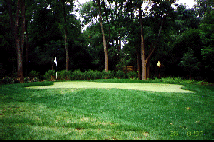
For severe cases of necrotic ring spot, renovation to tall fescue or resistant varieties of Kentucky bluegrass is the best long-term solution. For putting greens, a fertility program using ammonium-based nitrogen sources and periodic applications of manganese sulfate can significantly reduce disease pressure. Unfortunately, fungicides are usually needed on putting greens with high disease pressure to control take-all. Control recommendations both cultural and chemical--can be found in the UK Extension publication PPA-1, Chemical Control of Turfgrass Diseases, available from county Extension agents and on the Worldwide Web .
Flowering dogwoods (Cornus florida) in many landscapes are showing symptoms and signs of powdery mildew. This disease, first noticed in the mid-1990's has been active in Kentucky for almost a decade. The timing for symptom appearance is consistent with our previous years' experiences, however for this early in the season, the disease appears to be a little more severe and signs more visible. Considering the lengthy periods of high humidity seen in Kentucky this unusually wet spring, it shouldn't be surprising that powdery mildew is more prevalent.
Symptoms and signs. On susceptible dogwoods, powdery mildew symptoms are not all that evident yet, but the white powdery mycelium and spores of the fungus (signs) are very visible. This pathogen is an obligate parasite and under ideal conditions for development, such fungi often colonize and produce fungal signs prior to strong symptoms. It is expected that later in the season, affected parts of leaves will develop a mottled yellowing or turn light green or yellow and often develop brownish patches. Yellowed leaves may fall. In some cases, a very light coating of the causal fungus can just barely be seen, and occasionally, small patches of the fungus are fairly visible. Often the disease begins as barely distinguishable reddish brown or purplish irregular blotches on dogwood leaves which then develop into dark brown to tan dead patches. The combination of dead patches and leaf yellowing is most noticeable for homeowners.
What is being seen now is the typical white powdery mildew mycelium and spores developing abundantly on the new growth, distorting and curling these youngest leaves. It is likely that many of these curled leaves will later become scorched with brown leaf margins and interveinal dead patches. The disease increases progressively from early June to early September. Severely affected trees may appear wilted and browned by late summer. Landscape dogwoods exposed to sunlight and dry soil conditions may be especially scorched.
Cause. The fungal signs present now are the asexual Oidium stage which produces chains of white conidia. On leaves late in the season and on fallen leaves in fall and winter, ascocarps (cleistothecia, the sexual stage) of both Microsphaera and Phyllactinia spp. have been found, so this disease may involve two fungi. Although wet leaves favor most landscape plant diseases, powdery mildew is an exception. Like other powdery mildews, dogwood powdery mildew is favored by relatively dry, but humid weather. Yet, this very wet spring weather has also been favorable for the disease. This may be due to the continued succulent growth which is occurring this year, growth that is highly susceptible to powdery mildew.
How powdery mildew might affect dogwoods. Powdery mildew has affected flowering dogwoods in Kentucky landscapes for several years. Although it probably weakens trees, it does not appear to be lethal. We have observed that under high disease pressure, flower production is decreased the following year. Powdery mildew most likely reduces plant photosynthesis and increases leaf water loss through disruption of the cuticle and through the superficial fungal mycelium. In the long run, this could weaken trees making them more prone to dogwood borer or Botryosphaeria canker. In reality, the long-term effects of powdery mildew disease development on tree health are not known. Most landscape dogwoods are grown from seedling sources, so the mildew susceptibility of individual dogwood trees in landscapes varies greatly.
Disease management. Powdery mildew can be confronted by using cultural practices, planting resistant dogwoods, and by using fungicides.
When using fungicides for powdery mildew
management, be sure that dogwoods are listed on the
label and carefully follow all label directions.

Last week the EPA approved the registration of Poncho as an insecticide treatment of corn seed. Poncho is produced by Bayer CropScience and uses clothianidin as the active ingredient. This is a seed treatment that must be ordered on the seed and cannot be applied on farm. Clothianidin is in the neonicotinyl class of insecticides and is similar to imidacloprid (Prescribe) and thiamethoxam (Cruiser). Studies at the University of Kentucky have indicated that Poncho can provide good control of black cutworm and corn rootworm. It should also control the other secondary soil insect pests of corn.
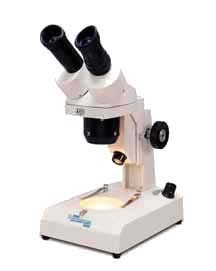
Samples of field crop diseases during the past week included Aphanomyces root rot and Lepto leaf spot on alfalfa and zinc deficiency on corn (due mainly to continued cool, wet weather). In tobacco we have seen Botrytis blight (blighting tops and producing lower stem cankers); Pythium root rot, Rhizoctonia damping-off; target spot; and yellowing of the bud and youngest leaves due to cold injury (particularly in plants from the field).
On fruit, vegetable and herb samples, we have seen crown gall and anthracnose on grape; anthracnose (fruit rot), Mycosphaerella leaf spot and Phomopsis leaf blight on strawberry; black knot on plum; Rhizoctonia stem rot on bean; bacterial wilt and Cercospora leaf spot on cantaloupe; bacterial canker; Botrytis fruit rot, bacterial spot and Septoria leaf spot on tomato; and Botrytis blight on basil.
On ornamentals and turf, we have diagnosed downy mildew on foxglove; Botrytis blight on peony and vinca; Septoria leaf spot on rudbeckia; brown patch on fescue; necrotic ring spot on bluegrass; black spot and rosette on rose; black root rot on holly; Phyllosticta leaf blotch on witch hazel; Phomopsis twig blight on juniper; anthracnose on ash and oak; Lecanium scale and jumping oak gall on oak; tip blight on pine and Cytospora canker on spruce.
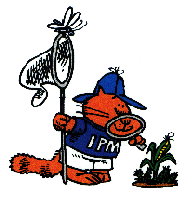
UKREC-Princeton, KY, May 30 - June 6| Black cutworm
| 0
| True armyworm
| 12
| European corn borer
| 2
| Southwestern corn borer
| 6
| Corn earworm
| 9
| | |
NOTE: Trade names are used to simplify the information presented in this newsletter. No endorsement by the Cooperative Extension Service is intended, nor is criticism implied of similar products that are not named.
Lee Townsend
Extension Entomologist